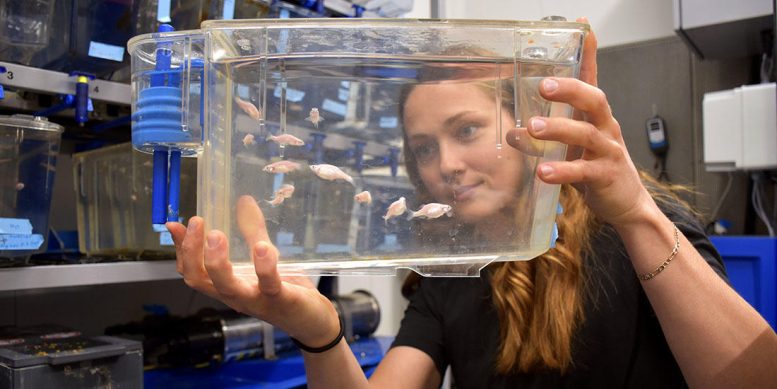
The researchers found that heat turns off the brain.
Zebrafish experiments demonstrate how vulnerable freshwater and marine species may be impacted by climate change.
When the climate changes, which organisms survive and which die? A small larval fish is offering unexpected insight into how the brain reacts to rising temperatures.
“It was pretty incredible, actually. The whole brain lit up,” said Anna Andreassen, a Ph.D. candidate at the Norwegian University of Science and Technology (NTNU).
Living organisms, whether it be fish or humans, tend to function worse as the temperature increases. Many people have probably gone through this on a summer day that was a bit too hot. But what precisely occurs inside the body when it becomes uncomfortably warm?
In order to figure out the answer, biologists from NTNU’s Department of Biology have combined genetic technology with neurophysiological techniques.
“We wanted to look at the mechanisms that limit organisms’ thermal tolerance. Which animals will survive when the Earth’s temperature increases due to climate change, and why? We chose to look at the brain,” says Andreassen.

Zebrafish play the lead role when Ph.D. candidate Anna H. Andreassen conducts experiments to find out how brain cells react to temperature changes. Credit: Ingebjørg Hestvik
Climate change causing heat waves

Anna H. Andreassen, a Ph.D. candidate at NTNU. Credit: Norwegian University of Science and Technology
Animals that dwell in water are experiencing temperatures that are increasing to fatal levels, and heat waves that traverse continents are getting more frequent. To forecast how species will adapt to climate change, it is essential to understand what limits survival at very high temperatures.
“Thermal tolerance is a topic that has been researched for decades, and the idea that temperature affects brain activity is an old one. What’s new is that we can now use genetic technology and neurophysiology to study the phenomenon,” says Andreassen.
Researchers at NTNU in Trondheim studied the brain activity of newly hatched zebrafish larvae while progressively raising the temperature around the larval fish.
“These fish have been genetically modified so that the neurons in the brain give off a fluorescent light when they’re active. We can see this light under a microscope while the larvae swim around. These larval fish also have the advantage that they’re transparent. We get to look directly into the brains of the living larvae,” says Andreassen.
Lose the ability to respond
In this way, the researchers can follow brain activity while gradually increasing the temperature of the water that the fish are swimming in.
“We can see how the larvae behave as it gets warmer. When it starts to get extremely warm, they lose their balance and start swimming around in circles, belly up.”
The researchers poked the fish larvae to check their response. They nudged the larvae’s tails, which normally triggers a swimming response.
“At a certain temperature, the fish stopped reacting to the pokes. They were still alive, but in an ecological sense, they could be considered dead. In that condition out in nature, they wouldn’t be able to swim away from predators or find their way to colder water,” says Andreassen, who adds that this condition is only temporary in the small experimental fish.
“They’re in just as good shape as soon as we get them into cooler water again,” says Andreassen.

Researchers use fish to get answers to many questions in biological research. Departmental engineer Eline Rypdal (right) assists with animal care. Credit: Ingebjørg Hestvik
Heat turns off the brain
So far, the experiments had gone as the researchers were expecting. By shining light in front of the fish’s eyes, they could also check whether the brain was perceiving visual impressions. As the temperature rose, the brain completely stopped responding to stimuli and was completely inactive. But then, when they turned the temperature up a little more, something happened.
“The whole brain lit up. The closest I can come to describing what we saw was a kind of seizure,” says Andreassen.
Normally, you only see brain activity in the form of small spots of light in defined parts of the brain. Now the amazed researchers could observe under the microscope how the fluorescent light spread out within a few seconds and covered the entire brain of the small fish larva.
“We know that zebrafish brains have quite a lot in common with the human brain – 70 percent of the genetic material is the same – and researchers have speculated whether there could be a connection between what we saw in these fish larvae and what you see in the brains of children who have a fever,” says Andreassen.
Next, the researchers want to put a special type of brain cell – glial cells –under the microscope.
“What we’re excited to investigate here is the activity of glial cells during heating. These cells play a central role in the oxygen supply to the brain – they both check the oxygen level and regulate the blood flow and thereby the oxygen supply. Because we can see that oxygen levels affect thermal tolerance, one hypothesis is that the brain stops working because the glial cells are no longer able to regulate the oxygen level.”
Differences advance evolution
In order to take a closer look at what happened, the researchers in Trondheim began to manipulate the amount of oxygen in the water the fish were swimming in, while increasing the temperature.
“To our surprise, we found that the oxygen level played a part in controlling the thermal tolerance. When we added extra oxygen, the larval fish did better at high temperatures, had higher brain activity, and also recovered faster from being exposed to upper thermal limits compared to the fish with low oxygen.
Studies of other species have yielded contrasting results when testing the effect of oxygen concentration on thermal tolerance.
“Being ‘insensitive’ to fluctuations in oxygen levels could thus be an evolutionary advantage as the temperature on Earth rises.
“The findings show that thermal tolerance is something that varies between species. This could be a characteristic that determines whether a species is able to adapt to climate change or will succumb to rising temperatures. A lot of organisms live in oxygen-poor environments where temperatures can quickly become higher than normal. They’ll be especially vulnerable,” says Andreassen.
She gives as an example organisms that live in shallow freshwater areas, in rivers, or in the intertidal zone.
“These are habitats where large fluctuations in the oxygen level can occur, often at the same time as temperature fluctuations. In these habitats, fish whose thermal tolerance is limited by the oxygen level are likely to struggle more than fish who are not affected by it. Animals that manage to maintain nerve function under low oxygen levels might be the ones that will tolerate high temperatures best,” says Andreassen.
Reference: “Brain dysfunction during warming is linked to oxygen limitation in larval zebrafish” by Anna H. Andreassen, Petter Hall, Pouya Khatibzadeh, Fredrik Jutfelt and Florence Kermen, 19 September 2022, Proceedings of the National Academy of Sciences.
DOI: 10.1073/pnas.2207052119









This is your brain on heat? Be afraid, be very afraid. Yet …
If there really were an “existential threat to the planet” posed by a couple of degrees of warming, how did Life-as-We-Know-It survive the many previous warm periods since the start of the Pleistocene epoch? For example, the Holocene Optimum some 8000 years ago was warmer than today: there is no evidence of a catastrophe. Previous extinction events correlate with glacial periods, not the warm interglacials such as the current one, which may be coming to an end.